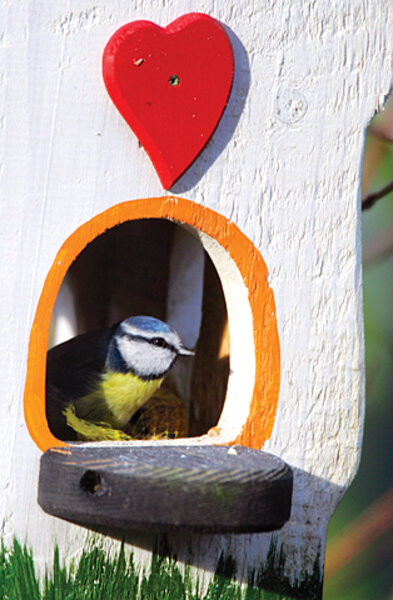Attraction: Not just for the birds
Loading...
When your daughter tells you she wants to make a birdhouse, what she means is she wants you to sketch out the gable ends and the sidewalls and the roof pieces and the floor piece on a sheet of plywood and then cut the pieces on the table saw and then glue the pieces together and then cut the hole and then add a little dowel perch. And then your daughter will take the birdhouse out to the backyard and paint it Day-Glo pink with flecks of yellow and orange and red and blue and green, like an electric disco party for Barbie dolls, and then she will present it to her mother and say, "Mommy, see the birdhouse I made?"
Lucy has a special little balcony on the east side of her bedroom. It's a quirk of house design that was necessitated by the sweeping, concave roof over the sunroom directly below. She has a four-by-five little place with a short knee wall where she has displayed little clay pots filled with flowers. Lucy opened her window and placed her disco birdhouse on the knee wall between the flower pots. Looking at it from the neighbor's driveway, I could see that the birdhouse was sort of high and narrow with a steeply-pitched roof. It was a cool-looking thing. "When do you think a bird will live there?" said Lucy. She is always impatient. "I don't know," I said. "But a bird will live there. Wouldn't you want to live there?" "It's a little bright," said Lucy.
That was last spring. No bird saw fit to live in Lucy's birdhouse. Not all summer long. Not a bluebird. Not a swallow. Not a sparrow. No bird.
There are reasons. Different birds, apparently, require different living situations. A chickadee, for instance, needs a hole that is 1-1/8 inches in diameter and that hole must be from 4-8 inches above the floor. There's even a certain width and depth and height that a chickadee requires. Apparently. According to the professional birdhouse builders that offer free birdhouse plans online. A titmouse, on the other hand, will not live anywhere other than a place where the hole is 1-1/4 inches. A Western Bluebird requires 1-1/2. And if you want to build a birdhouse that will suit a barn swallow, you can't have a hole at all. What you need is only a roof and a ledge.
"If you could have a super power, what would it be?" That's Lucy's question.
"I'd fly," I say. "How about you?"
"I don't know," she says. "I guess I'd fly, too."
"What's your favorite bird?" That's Lucy's next question.
I have responded to this question, from each of my four children, differently through the years. For a while I liked the meadowlark most because the bird is such a contradiction, looking so shaggy and disheveled as it does, with its fat belly and wing tips hanging down like an untucked shirt. But the song. Like a synthesized harmonica, something that cannot be duplicated by any other bird. I've always liked catbirds because they are gray and have a black cap and they can mock other birds while their own call is so grating. When I was a child, they would call and call over the blueberry marshes. I like crows because everyone hates them. I like blue jays because my wife likes them. But, at the moment, I like barn swallows the most because they are rainbow colored and they look like ornamental kites and they fly like miracles and if I were a bird, I'd want to fly that way. "Barn swallows," I say. "How about you?"
"I don't know," says Lucy. "I guess barn swallows."
Lucy is 10 years old. She's been a little kid her whole life and there hasn't been much to worry about. But recently, a seed of concern has begun to grow. What about boys? What do they think of her? Is she pretty?
Lucy likes a boy named Cody. But Cody likes a girl named Prudence. And Lucy wonders why that is.
"Am I fat?" Lucy asked her mom, in hushed tones.
"That's ridiculous!" said Deb. "You're not fat at all! You're perfect! Did someone say that?"
Lucy wouldn't let on. And when Deb repeated the question, Lucy began to cry.
"Somewhere," said Deb, gathering Lucy in her lap, "the boy you're going to marry is doing something right now. I don't know what. Maybe he's brushing his teeth. I don't know. But he's somewhere out there. You just don't know where yet."
I don't know how big the hole is that I drilled in Lucy's birdhouse. I don't know how high that hole is from the floor. I don't know whether or not birds can see color. I'm thinking they probably can. Why else would so many of them be so brightly colored? They say it's to attract a mate. To bring something to them they do not already possess, if there can be such a thing. Something more than a brilliant song. More than physical beauty. More than the ability to fly. To swoop. To dive. More than all of this. To have someone come to you. To have a desire to make a home with you. To stay with you. To be your mate for life. To have children with you. To love you. Isn't that the way it goes?
"What's wrong with my house?" says Lucy. We're both in the neighbor's driveway, looking up at the too-tall, too-narrow, bright-pink birdhouse on the ledge of Lucy's little balcony. "Do you think it's the color?"
"No, honey," I say. "It's the perfect color."





